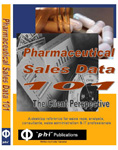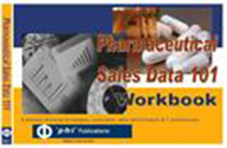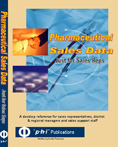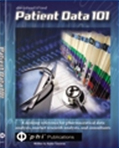Pharmaceutical Sales Data 101, The Client Perspective
‘ Pharmaceutical Sales Data 101, The Client Perspective’ is our original publication. Phi Publications introduced the book in 2003. The book provides an overview of the pharmaceutical market and discusses in-depth some of the industry's main data: sales data, prescription data, and plan reimbursement data. Sales data is the basis for measuring overall product performance, and account performance in the non-retail channel. Prescription data is the basis for measuring product performance at the prescriber level, and reimbursement data is the basis for measuring payer performance.
‘Pharmaceutical Sales Data 101, The Client Perspective’ packs general industry information and trivia together to make it a unique industry resource and a desktop reference for everyone. The book is written from the data user's point of view. Its top-down approach builds the basic knowledge foundation to put the data in perspective. It highlights the strengths of the data but more importantly discusses the implications of the weaknesses to the key sales applications. Its basic principle is that you can make better use of the data by understanding and successfully dealing with the data weaknesses rather than merely focusing on the data strengths.

‘Pharmaceutical Sales Data 101, The Client Perspective’ packs general industry information and trivia together to make it a unique industry resource and a desktop reference for everyone. The book is written from the data user's point of view. Its top-down approach builds the basic knowledge foundation to put the data in perspective. It highlights the strengths of the data but more importantly discusses the implications of the weaknesses to the key sales applications. Its basic principle is that you can make better use of the data by understanding and successfully dealing with the data weaknesses rather than merely focusing on the data strengths.
‘Pharmaceutical Sales Data 101, The Client Perspective’ supports the idea of an overall data implementation strategy. It provides enough detail to implement a complete data management process; from data acquisition to data quality, data processing and reporting. It covers common practices used extensively by the industry without necessarily endorsing them as 'best practices'; in fact, sometimes recommending against them.
‘Pharmaceutical Sales Data 101, The Client Perspective’ introduces the new hire to the pharmaceutical market and its players. With its wealth of information, it substitutes years of on-the-job training, shortens drastically the learning curve of analysts, and boosts their productivity rapidly and inexpensively. It expands the knowledge of the seasoned professional, clarifies concepts and fills-in the knowledge gaps. The book provides sales administration staff the knowledge they require to support the sales force. Analysts gain the confidence in the data to present solutions with conviction and earn the trust of the sales reps. The book is the window into the business world for IT professionals who typically do not get the exposure to business. It emphasizes objectives over technologies that make a successful operation. It brings consultants working with a multitude of industries rapidly up to speed with the concepts and data of the pharmaceutical industry to meet the high expectations of their clients.
The data discussion in ‘Pharmaceutical Sales Data 101, The Client Perspective’ is organized in three sections: DDD sales data, Xponent prescription data, and Xponent PlanTrak payer reimbursement data. DDD sales data tracks the transactions from the manufacturer, to wholesalers, to healthcare provider sites. Sales data is the cornerstone of a manufacturer’s data foundation and is used more often than any other type of data in the industry. DDD sales data is the most commonly used product of its kind. ‘Pharmaceutical Sales Data 101, The Client Perspective’ provides a very thorough discussion of DDD sales data.
Xponent prescription data tracks physician level prescribing activity for all but over-the-counter drugs. Prescription data is the single most important data for identifying and ranking prescribers for a certain product. Prescription data covers only the retail (pharmacy) market of the business. ‘Pharmaceutical Sales Data 101, The Client Perspective’ provides thorough coverage of the prescribing process and prescription data. Payer reimbursement data is an extension of the prescription data identifying the payer reimbursing for a given transaction. ‘Pharmaceutical Sales Data 101, The Client Perspective’ also covers the essentials about Xponent PlanTrak data.
Click here to learn more about sales, prescription, and payer reimbursement data.
Pharmaceutical Sales Data 101, Workbook

‘Pharmaceutical Sales Data 101, Workbook’ is our newest publication. It was written to complement 'Pharmaceutical Sales Data 101, The Client Perspective’, which covers the theory behind the data, by providing actual examples in full color depictions.
A concept is illustrated using text, data tables, charts, and diagrams, giving the user a visual perspective. A page header introduces the topic discussed. The main body of the page is where the concept is illustrated. Call-outs are used to clarify data elements, processes, properties, flows, etc. An adjacent notes page is provided for the user's own purpose. Click here to see sample pages.
The 'Pharmaceutical Sales Data 101, Workbook’ is not intended for standalone use. The workbook by itself lacks the general industry background and definitions, or the in-depth data discussion found in the original book. However, when used together, the book accelerates drastically the reader's comprehension of the data concepts. It can take, literally, several months of on-the-job practice and learning and fast forward an analyst's performance to a much higher level. Readers can apply on the job the concepts in the book just by following the examples.
Click here to learn more about sales, prescription and payer reimbursement data.
Pharmaceutical Sales Data, Just for Sales Reps
‘Pharmaceutical Sales Data 101, Just for Sales Reps’ is a custom version of the 'Pharmaceutical Sales Data 101, The Client Perspective'. It includes the market, customer and product overviews; however, the sales, prescription, and plan data discussions have been modified to what is relevant for the sales reps. ‘Pharmaceutical Sales Data 101, Just for Sales Reps’ excludes the technical data discussion applicable only to analysts and IT staff. Additionally, this book includes a new chapter on performance metrics. This chapter directs the sales rep's attention to the true meaning of the pharmaceutical sales data, prescription data and what is important for his performance.

‘Pharmaceutical Sales Data 101, Just for Sales Reps’ allows sales training to maximize classroom time for the more critical product training while allowing reps to obtain the data knowledge through home-study. It also provides the rep with the depth and detail not afforded in the abbreviated class sessions. The book addresses the issue of low sales rep confidence in the data. This is a rather common occurrence throughout the industry and one that many companies avoid dealing with, further weakening the rep's confidence. ‘Pharmaceutical Sales Data 101, Just for Sales Reps’ helps sales reps separate the myths from the realities of data quality. Together with the suggested solutions for the data limitations it brings more transparency to the overall data quality issue.
The DDD sales data discussion in ‘Pharmaceutical Sales Data 101, Just for Sales Reps’ provides a thorough overview on overall sales performance and sales data for non-retail products. The sales rep learns about the use of sales data for targeting and compensation purposes. The Xponent prescription data discussion provides an overview of the flow of data from the doctor’s office to the pharmacy, and the transformation of the data to actionable physician-level targeting tool. The sales rep learns how to effectively use Xponent prescription data for targeting and compensation. Finally, the sales rep learns how to use Xponent PlanTrak payer reimbursement data to evaluate the influence of healthcare plans on their business.
Click here to learn more about sales, prescription and payer reimbursement data.
Patient Data 101

Patient Data 101’ was written for pharmaceutical and biotechnology business and market research analysts, consultants, and data vendors with a focus in the area of patient data. It is intended to provide an introduction to the basic concepts and uses of longitudinal patient data. For the novice data user, it provides the foundational knowledge to start engaging with data applications, while it expands the knowledge or clarifies ideas for the more advanced user. ’Patient Data 101’ focuses on two key areas: the theoretical framework of patient data and the key patient data applications. It examines the roots of the data, its communication paths to becoming a product, the business functions that cause it to exist, the key players and stakeholders involved, and the data transformation process that results in the development of the patient data products.
’Patient Data 101’ covers the various types of patient data from registries, survey-based, reimbursement claims, and electronic medical records. The book focuses extensively on claims data given its prominence and extensive use in most applications today. The book covers all aspects of claims data, from the pharmacy claims and the NCPDP standard, to professional claims and the CMS-1500 standard, and institutional claims and the UB-04 standard. ’Patient Data 101’ discusses thoroughly the claims process, the routing of the transactions, the data capture, and data transformation processes. It provides lists of data elements and highlights the ones with particular meaning to patient data analysis and patient data applications. The book discusses the various types of claims databases and the advantages and disadvantages with each. ’Patient Data 101’ explains the roles of data vendors, providers, and claims switches in the development of the patient data databases.
’Patient Data 101’ provides an overview of electronic medical records. It begins by discussing the functionality of electronic medical records systems and standards. The discussion enables the analyst to see the possibilities with electronic medical records data and contrasts it against claims data. Insights from the book help the analyst to determine whether claims data or electronic medical records data is more applicable to their applications by recognizing the limitations of each.
The applications section in ’Patient Data 101’ covers the major types of analysis conducted using patient data. The applications are divided in four categories: Treatment and Utilization Patterns, Brand Performance, Epidemiology, and Parmacoeconomics and Outcomes. The list of applications include patient population estimation and patient share, therapy progression analysis, drug dosing and titration, mode of therapy analysis, referral pattern analysis, drug use by indication, treatment adherence and patient persistency and compliance, source of business, physician segmentation and targeting, patient segmentation, direct-to-patient program analysis, epidemiology, diagnosed vs. treated patient population estimates, disease staging, co-morbidity analysis, burden of illness analysis, medical outcomes, time value of the patient, health and productivity analysis, reimbursement analysis, claims rejection and claims reversal analysis, price sensitivity analysis, co-pay analysis, and Medicare Part-D analysis.
Click here to learn more about longitudinal patient data.

